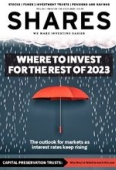Archived article
Please note that tax, investment, pension and ISA rules can change and the information and any views contained in this article may now be inaccurate.
Why is my pension projected to be worth less than my contributions?

In 2016, I was automatically enrolled into a pension scheme via my workplace. I increased my contributions to 10% of earnings around four years ago.
I have recently checked my projected funds at retirement based on my current contributions. It projects that my final pension pot at retirement (September 2030) will be less than £40,000.
At this projection it will be worth less than the amount I will be putting in. Can this possibly be right?
Brian
Tom Selby, AJ Bell Head of Retirement Policy, says:
For readers who are unfamiliar, ‘automatic enrolment’ is the name of reforms introduced from 2012 which require all UK employers to offer their staff a workplace pension.
Not everyone who is employed will be auto-enrolled into a pension, however – you need to meet certain criteria to qualify. You must be:
Aged 22 or over
Earning at least £10,000 a year
Aged below state pension age (currently 66, rising to 67 by 2028)
Employers also have the option of deferring auto-enrolment for new employees for up to three months. In addition, if you are self-employed, you will not have access to a workplace pension with matched employer contributions.
Minimum contributions under auto-enrolment are 8% of ‘qualifying earnings’, with 4% of that coming via employee contributions, 3% from the employer and the final 1% via pension tax relief. In the 2023/24 tax year, qualifying earnings against which contributions are calculated are earnings between £6,240 and £50,270. Businesses are free to pay contributions above this level, and many do as part of their employee benefits offering.
Your auto-enrolment contributions then need to be invested in a diversified mix of assets, with the aim of maximising long-term returns and ultimately the retirement pot you draw an income from, in line with your risk appetite.
If you do nothing, your pension will be invested in your scheme’s ‘default’ fund. This fund is designed to be broadly appropriate for the entire membership of the pension scheme – and as such will not be tailored to your preferences and risk appetite. Auto-enrolment default funds are subject to a 0.75% charge cap.
Your scheme may offer alternatives to the default, although these will not be covered by the 0.75% charge cap. However, schemes are under no obligation to offer investment choice to members beyond the default.
Lack of growth a concern?
Turning to your specific question, I can understand your frustration at the projection you have received. It’s important to note that a projection is just that – your provider’s best guess at what your fund might be worth at a certain date, based on a range of assumptions, including your contributions and investment returns. It is possible those returns will exceed expectations – although they could end up being lower too.
Investing is a long-term game, with the aim of achieving returns over decades, but with the price of those returns coming through volatility, particularly in the short-term. Unfortunately, since 2016 parts of the global stock market have been in a bit of a funk, in large part as a result of the pandemic. The FTSE 100, for example, is at roughly the same level today as it was five years ago although this doesn’t account for the dividends those investments pay out to investors.
So, while this probably won’t provide much comfort, you are certainly not alone in seeing your retirement investments perform below expectations. One thing to remember is that, based on what we have seen historically, the longer you stay invested, the better the chance of your fund achieving growth.
It is possible to stay invested while taking an income from your pension in retirement via drawdown – although you need to be comfortable taking risks and have the time and inclination to keep track of your investments and withdrawal strategy.
Transferring your pension
Most people saving for retirement in the workplace will not be able to choose which pension scheme their auto-enrolment contributions go to (although schemes such as Nest do usually offer a small selection of different funds outside the default).
If you are fundamentally unhappy with the way your investments are performing or don’t have the option of a fund that matches your goals and risk appetite within your auto-enrolment scheme, you can choose to transfer your existing pension to a different provider.
There are several potential benefits to doing this, including increased choice, greater flexibility when you come to taking a retirement income, and in some cases lower costs and charges. When it comes to investing, having a choice of investments can allow you to build a retirement strategy which better suits your personal preferences.
Before making the leap, you need to be clear of the risks as well. If you transfer your auto-enrolment pension, you will be leaving an environment protected by a 0.75% charge cap and moving your money into a world without a charge cap.
It is perfectly possible to build a suitable, well-diversified retirement strategy for much less than 0.75% in a pension outside auto-enrolment, such as a SIPP, but you need to be careful not to end up paying over the odds. Remember that investing is a long-term game, so you need to be comfortable with the risks you are taking and be prepared to ride out any short-term bumps in the road.
You also need to make sure you are transferring to a bona fide, FCA-regulated scheme that you trust. Although most scams are now outside of pensions, it is still vital to be sure your money isn’t at risk of falling into the wrong hands.
In addition, it’s worth checking you won’t lose any valuable guarantees or expose yourself to high exit charges by transferring your pension. This is more likely to be the case where someone has an older-style pension, as more modern schemes – including those used for auto-enrolment – don’t tend to have these features. It’s also worth speaking to your employer to see if they are willing to pay your auto-enrolment contributions into your chosen scheme.
DO YOU HAVE A QUESTION ON RETIREMENT ISSUES?
Send an email to asktom@sharesmagazine.co.uk with the words ‘Retirement question’ in the subject line. We’ll do our best to respond in a future edition of Shares.
Please note, we only provide information and we do not provide financial advice. If you’re unsure please consult a suitably qualified financial adviser. We cannot comment on individual investment portfolios.
Important information:
These articles are provided by Shares magazine which is published by AJ Bell Media, a part of AJ Bell. Shares is not written by AJ Bell.
Shares is provided for your general information and use and is not a personal recommendation to invest. It is not intended to be relied upon by you in making or not making any investment decisions. The investments referred to in these articles will not be suitable for all investors. If in doubt please seek appropriate independent financial advice.
Investors acting on the information in these articles do so at their own risk and AJ Bell Media and its staff do not accept liability for losses suffered by investors as a result of their investment decisions.
Issue contents
Feature
Great Ideas
Investment Trusts
News
- Why gamblers 888 and DraftKings have seen diverging share prices
- Gresham House takeover highlights undervaluation of UK asset managers
- Why American Airlines shares have soared year-to-date
- Vanquis Banking shares have lost almost 20% in six weeks and could face FTSE 250 relegation
- Nasdaq 100 benchmark is shuffling its weightings after AI tech stock surge

 magazine
magazine








